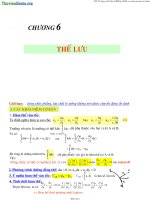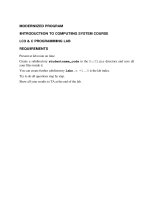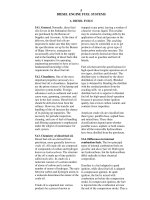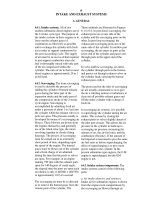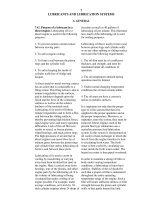Tài liệu COATING TECHNICAL FILE pdf
Bạn đang xem bản rút gọn của tài liệu. Xem và tải ngay bản đầy đủ của tài liệu tại đây (2.01 MB, 38 trang )
(219) SHEETS WITH A COVER
For Painting
CLASS : DNV/VR
DATE : 2008 - 04 - 16
PROJECT :
105,000DWT CRUDE OIL TANKER
Approved by
Nguyen Duc Vinh
M/V :
Checked by
OWNER :
PVTRANS
Tran Quang Thinh
Drawn by
Cao Van Hung
HULL No.
PVT 831
COATING TECHNICAL FILE
Drawings No.: 122-P. 01
DUNG QUAT SHIP YARD
Table of content
Rev.: 02
COATING TECHNICAL FILE
1. Type Approval Certificate: ……………………………………………………..
3
a. Shopprimer :………………………………………………………………….
b. Main Coating : ……………………………………………………………….
2. Technical Data sheets :…………………………………………………………..
2.1 Product Data sheet (PDS): ………………………………………………...
2.1.1. Product Data sheet of shopprimer: ……………………………………
2.1.2. Product Data sheet of main coating: ..………………………………..
2.2. Material Safety Data sheet (MSDS) :………………………………………
2.2.1. Material Safety Data sheet of Shopprimer: …………………………..
2.2.2. Material Safety Data sheet of Main Coating : ………………………..
2.3 List of Water Ballast Tanks: ………………………………………………
2.4. Painting Work Specification: ……………………………………………...
2.4.1. Introduction: …………………………………………………………..
2.4.1.1. General note: …………………………………………………….
2.4.1.2. Painting procedure: ……………………………………………..
2.4.1.3. Surface preparation: ……………………………………………..
2.4.1.3.1. Primary Surface preparation (PSP): ……………………...
2.4.1.3.2. Secondary Surface preparation (SSP): …………………...
2.4.1.3.3. Miscellaneous: ……………………………………………
2.4.1.4. Application Of Coating: ………………………………………….
2.4.1.5. Material Protections of pipes: ……………………………………
2.4.1.6. Description of compartment division for the painting scheme: ….
2.4.1.7. Arrangement of separation lime for painting shell outside: ……...
2.4.1.8. List of paints:……………………………………………………..
2.4.2. Specification sheet: ……………………………………………...........
2.4.3 Safety regulations for painting work: …………………………………
2.4.3.1. General prevention for surface preparation: ……………………..
2.4.3.2. Painting safety work: …………………………………………….
2.4.3.3. Necessary regulations: …………………………………………...
2.4.3.4. Preliminary method in case of emergency: ………………………
3. Certificate of blast material: …………………………………………………….
4. Certified/qualified Coating inspector: ………………………………………….
5. Useful coating life of paint system for ballast tank: ……………………………
3
6
34
34
34
39
46
46
60
70
71
71
71
73
74
74
74
75
76
81
82
83
84
85
196
196
196
197
199
200
201
202
203
203
204
205
206
207
208
209
6. Daily logs:………………………………………………………………………………
6.1. Primary Surface Preparation (PSP): ………………………………………………..
6.2. Secondary Surface Preparation (PSP) - Block assembly: ………………...
6.3. Secondary Surface Preparation (PSP) – Erection: ………………………….
6.4. Non - Conformity report: ……………………………………………………
6.5. Coating Application: ………………………………………………………..
6.6. Dry film thickness (DFT) measurement : …………………………………..
7. Shipyards verified inspection report : …………………………………………..
67
COATING TECHNICAL FILE
7.1. Inspection sheet for surface preparation and painting application: …………
7.2. Final Inspection report: ……………………………………………………..
8. Procedures for in-service maintenance and repair of coating system: ………….
9. Inspection agreement between ship-owner, shipyard and coating manufacturer
for painting work: ……………………………………………………………...
9.1. Scope: ………………………………………………………………………..
9.2. General conditions: ………………………………………………………….
9.3. Communication and meetings: ……………………………………………...
9.4. Inspection :…………………………………………………………………...
9.5. Planning: …………………………………………………………………….
9.6. Surface preparation and paint application: ………………………………….
9.6.1. Primary surface preparation (PSP):……………………………………….
9.6.2 Secondary surface preparation (SSP): …………………………………….
9.7. Measurement of dry film thickness: …………………………………………
9.8. Exception reports: …………………………………………………………...
9.9. Repairs: ……………………………………………………………………...
9.10. Coating Inspectors: ……………………………………………………........
1. Type Approval Certificate
a. Shopprimerb. Main Coating
2. Technical Data sheets
68
209
210
211
212
212
212
213
213
214
214
214
214
215
216
216
216
COATING TECHNICAL FILE
2.1 Product Data sheet (PDS)
2.2. Material Safety Data sheet (MSDS)
2.3.
LIST OF WATER BALLAST TANKS:
TANK NAME
F.P.T (W.B)
LOCATION
(FRAME)
98-FE
Volume
( M3 )
858.7
NO.1 W.B.T (P)
91-98
91-98
3236.9
NO.2 W.B.T (P)
84-91
2863.6
NO.2 W.B.T (S)
84-91
Blocks
2479.5 F21P/S, F22C, F11C
F11C, F21P, F31P, F41P, F51P, S24P,
9387.2 S25P, S26P, B54P, B55P, B56P, B24C,
B25C, B26C.
F11C, F21S, F31S, F41S, F51S, S24S,
9387.2 S25S, S26S, B54S, B55S, B56S, B24C,
B25C, B26C.
S22P, S23P, S24P, B52P, B53P, B54P,
8275.8
B22P, B23P, B24P, B22C, B23C, B24C.
8275.8 S22S, S23S, S24S, B52S, B53S, B54S,
3236.9
NO.1 W.B.T (S)
Area sq.m
2863.6
69
NO.3 W.B.T (P)
77-84
NO.3 W.B.T (S)
77-84
NO.4 W.B.T (P)
70-77
NO.4 W.B.T (S)
70-77
NO.5 W.B.T (P)
63-70
NO.5 W.B.T (S)
63-70
NO.6 W.B.T (P)
47-63
NO.6 W.B.T (S)
47-63
A.P.T (W.B)
AE-12
TOTAL
COATING TECHNICAL FILE
B22S, B23S, B24S, B22C, B23C, B24C.
S18P, S19P, S20P, S21P, S22P, B48P,
B49P, B50P, B51P, B52P, B18P, B19P,
2923.4
8419.4
B20P, B21P, B22P, B18C, B19C, B20C,
B21C, B22C.
S18S, S19S, S20S, S21S, S22S, B48S,
B49S, B50S, B51S, B52S, B18S, B19S,
2923.4
8419.4
B20S, B21S, B22S, B18C, B19C, B20C,
B21C, B22C.
S16P, S17P, S18P, B46P, B47P, B48P,
2923.4
8419.4
B16P, B17P, B18P, B16C, B17C, B18C.
S16S, S17S, S18S, B46S, B47S, B48S,
2923.4
8419.4
B16S, B17S, B18S, B16C, B17C, B18C.
S14P, S15P, S16P, B44P, B45P, B46P,
2880.1
8323.5
B14P, B15P, B16P, B14C, B15C, B16C.
S14S, S15S, S16S, B44S, B45S, B46S,
2880.1
8323.5
B14S, B15S, B16S, B14C, B15C, B16C.
E11C, E21P, E31P, E41P, E51P, S11P,
3560.4
10218.6 S12P, S13P, S14P, B41P, B42P, B43P,
B11P, B12P, B13P, B11C, B12C, B13C,
E11C, E21S, E31S, E41S, E51S, S11S,
3560.4
10218.6 S12S, S13S, S14S, B41S, B42S, B43S,
B11S, B12S, B13S, B11C, B12C, B13C,
1077.9
3115.6 A21C, A22C, A31P/S.
38712.2
111682.9
2.4 PAINTING WORK SPECIFICATION:
2.4.1. INTRODUCTION:
2.4.1.1 GENERAL NOTE:
2.4.1.1.1 This Painting Specification was prepared in accordance with the Contract Specification,
Shipowner and the Manufacturer’s recommendation.
2.4.1.1.2 Painting shall be applied in accordance with the Builder’s practice and the
Manufacturer’s recommendation and also with reference to the Manufacturer’s published
data sheets, particularly in regard to mixing and thinning of paint materials,
conditions/method of application and time interval between each coat.
2.4.1.1.3 Work stage of surface treatment & painting shall be in accordance with the Builder’s
practice and the Owner’s approval.
2.4.1.1.4 The colors of finish coats shall be in accordance with the Buyer’s color scheme in
consultation with the Builder, and those of primer coats shall be in accordance with the
Manufacturer’s recommendation.
2.4.1.1.5 Painting work for the parts which are not specified in this Specification shall be similar
to the surroundings or comparable spaces.
70
COATING TECHNICAL FILE
2.4.1.1.6. The steel structure surface including all welded beads to be painted before leak test, in
general. However, fillet welding joint and erection seams/butts forming tank boundary to
be painted after the jint has been examined either by compressed air test, vacuum test or
tank air test as appropriate.
Pre-erection joint of hull block to be paited before leak test and not to be considered as
block erection joint.
2.4.1.1.7 Painting shall not be applied to the following items unless otherwise specified.
1) Wood works in stores and lockers, polished fittings, gaskets, packing, non-ferrous
materials (i.e. copper, brass, bronze, aluminum alloy and other non-corrosive metals),
permanently enclosed space and any other surfaces of fittings and equipment where
paints would obstruct their proper functions.
2) Galvanized fittings, steel surface under deck covering (cement area)
3) Anodes for cathodic protection.
2.4.1.1.8 Steel outfitting manufactured by the subcontractor shall be coated as specified in this
Specification or with equivalent type of paint by the subcontractor’s standard. And the
coatings may be applied with the adjacent structure’s coating system for ease of
subsequent maintenance.
2.4.1.1.9 Equipment which the Builder shall purchase, i.e. main and auxiliary engines, electrical
equipment, navigation equipment, deck machinery, etc. shall be painted according to each
Manufacturer’s standard and the damaged part after installation to be touched up with one
coat of primer and one coat of finish paint.
2.4.1.1.10 Epoxy primer on outfitting, seats, etc. shall be applied with the Builder’s standard as
specified in this Specification.
2.4.1.1.11 The coating material shall be supplied by the following Paint Manufacturers.
- All items including shop primer : HEMPEL.
2.4.1.1.12 Entire ballast works both of new building and repair should be refer to Hempel’s
Technical Standard for Ballast Tank Coating Work (Doc. No.: BTC-0100-W, Rev. 04).
2.4.1.2 PAINTING PROCEDURE
71
COATING TECHNICAL FILE
delivery
2.4.1.
3
SURF
ACE
PREP
ARA
TION
2.4.1.3
.1.
Prima
ry
Surfa
ce
Prepa
ration
(PSP)
72
COATING TECHNICAL FILE
Oil and grease etc. to be removed by suitable emulsion cleaning
or suitable solvent, if any follow intructions of Hempel’s
Coating Advisor on site. Entire area to be (high pressure) fresh
water cleaned in order to remove salts and other contaminants.
1
Blasting and profile
2
Water soluble salt
limit equivalent to
NaCl
Sa 2.5; with profiles between 30-75 μm.
Blasting should not be carried out when:
.1 The relative humidity is above 85%; or
.2 The suface temperature of teel is less than 30C above the
dew point.
Checking of the steel surface clealiness and roughness
profile should be carried out at the end of the surface
preperation and before the application of the primer. In
accordance with the manufacturer’s recommendations.
≤ 50mg/m2 of sodium chloride.
2.4.1.3.2. Secondary surface preparation (SSP):
1 Steel condition
The steel suface shall be prepared so that the coating
selected can achieve an even distribution at the required
NDFT and have an adequate adhesion by removing sharp
edges, grinding weld beads and removing weld spatter and
any other surface contaminant.
Edges shall be treated to a rounded radius of minimun
2mm, or subjected to three pass grinding or at least
equivalent process before painting.
2 Surface treatment
Oil and grease etc. to be removed by suitable emulsion cleaning
or suitable solvent, if any follow intructions of Hempel’s Coating
Advisor on site. Entire area to be (high pressure) fresh water
cleaned in order to remove salts and other contaminants.
Sa 2.5 on damaged shopprimer and welds
Sa 2.0 removing at least 70% of intact shopprimer, which
has not passed a pre-qualification certified by test
procedures in 1.3.
If the complete coating system comprising epoxy-based
main coating and shopprimer has passed a pre-quilification
certified by test procedures in 1.3, intact shopprimer may be
retalned provided the same epoxy coating system is used.
The retained shopprimer shall be cleaned by sweep blasting,
high-pressure water washing or equivalent method.
If a zinc silicate shopprimer has passed the pre-qualification
test of 1.3 as part of an epoxy coating system, it may be
used in combination with other epoxy coatings certified
under 1.3, provided that the compatibility has been
confirmed by the manufacturer by the test in accordance
with 1.7 of appendix 1 to annex 1 without wave movement.
3 Surface treatment
after erection
Oil and grease etc. to be removed by suitable emulsion cleaning
or suitable solvent, if any follow intructions of Hempel’s Coating
73
COATING TECHNICAL FILE
Advisor on site. Entire area to be (high pressure) fresh water
cleaned in order to remove salts and other contaminants.
4 Profile requirements
5 Dust
6 Water soluble salt
limit equivalent to
NaCl after
blasting/grinding.
7 Oil contamination
Butts St3 or better or Sa2.5 where practicable.
Small damages up to 2% of total area: St3.
Contiguous damsges over 25m2 or over 2% of the total area
of the tank: Sa2.5 shall be applied.
Coating in overlap shall be feathered.
In case of full or partial blasting 30-75µm, otherwise as
recommended by the coating manufacturer.
Dust quantity rating ”1” for dust side class “3”, “4’ or “5”.
Lower dust side classes to be removed if visible on the
surface to be coated without magnification.
≤ 50mg/m2 of sodium chloride.
No oil contamination
2.4.1.3.3 Miscellaneous:
1 Ventilation
Adewuate ventilation is necessasy for the proper drying and
curing of coating. Ventilation should be maintained
throughout the application process and for a period after
application is completed, as recommended by the coating
manufacturer.
*SYMBOL OF SURFACE PREPARATION
SYMBOL
NO.
B3
T3
T2
AP
CL
PRIOR TO FIRST COAT
(BLOCK STAGE)
Blasting to Sa 2.5(*) (B3)
Power tool to St 3 (T3)
Power tool to St 2 (T2)
Power tool to St 2 (T2)
Or Pickling treatment (PK)
Dry and Cleaning (CL)
AFTER MAIN FIRST COAT
(P.E, DOCK/QUAY STAGE)
Power tool to St 3 (T3)
Power tool to St 3 (T3)
Power tool to St 2 (T2)
Power tool to St 2 (T2)
Dry and Cleaning (CL)
(*) Note : St 3 shall be applied for blocks of E/R and aft.
2.4.1.4 APPLICATION OF PAINT
74
COATING TECHNICAL FILE
2.4.1.4.1 When more than one coat is specified, subsequent coats not to be applied until preceding
coat has sufficient curing/drying time in accordance with the time interval which is
recommended by the paint manufacturer.
2.4.1.4.2 Painting shall be carried out by airless spray mainly. However, hand brush or roller brush
may be adopted where it is more suitable than spray.
2.4.1.4.3 A stripe coat shall be applied to the cut free edges of structural members, the edges of
holes such as slots, scallops, drain holes, air holes, and manual welding beads, where the dry
film thickness may not always be the specified, before or after the first coat according to the
Builder’s practice. Two (2) stripe coats shall be applied to the above area in water ballast
tanks and fresh water tanks.
Table1: Coating of Water Ballast tanks:
Name of coating
Coating
manufacturer
Colour
Specified
DFT (µm)
Min.
Max.
DFT
DFT
(µm)
(µm)
Application
SC/
method
FC
Zinc silicate 15890
Hempel
Grey
20
18
35
Automatic
FC
Hempadur 17630
Hempel
Red
160
144
600
Airless spray
FC
Hempadur 17630
Hempel
Red
Brush
SC
Hempadur 17630
Hempel
Grey
Brush or
SC
roller
Hempadur 17630
Hempel
Grey
Total
160
144
600
320
288
Airless spray
FC
1,200
Remark:
SC = Stripe Coating
FC = Full Coating
The second stripe coating (SC) may be applied after the secon spray coating (FC).
• For ballast tank coating dft of Shopprimer 15890 and Hempadur 17630, According rule “9010” , product data sheet & paint spec.:
-
Shopprimer 15890
DFTMIN = 20 x 0.9 = 18 micron of each coat, but no more than 10% of total reading
below specified dft.
DFTMAX = 35 micron of each coat
-
Hempadur 17630
DFTMIN = 160 x 0.9 = 144 micron of each coat, but no more than 10% of total reading
below specified dft.
DFTMAX = 600 micron of each coat.
75
COATING TECHNICAL FILE
2.4.1.4.4 The adhesive tape or equivalent may be used to protect the fillet joint and the erection
seams/butts for leak test or welding from contamination by surrounding painting.
2.4.1.4.5 Pre-primer shall be applied with shop coat primer, after suitable surface cleaning at the
hull shop.
2.4.1.4.6 If the maximum recoating intervals has exceeded, the surface treatment shall be done in
accordance whit the Manufacturer’s recommendation to ensure the inter coat adhesion
subject to Owner’s approval.
2.4.1.4.7 In case of the application of tar epoxy or epoxy paint during the winter season, the builder
may use the winter type paint recommended by the paint manufacturer.
2.4.1.4.8 The painting schedule specified hereunder may have alteration in number of coats and the
dry film thickness in accordance with standard specification of the paint manufacturer
selected subject to the Buyer’s approval.
2.4.1.4.9 After the specified coating is applied, the damaged parts of paint film shall be repaired at
proper time. When such a damage reaches to the steel surface and rust occurs, the surface
shall be cleaned by disc sander and shall be coated as originally specified subject to Owner’s
approval.
2.4.1.4.10 Small outfitting and fittings may be galvanized instead of painting.
2.4.1.4.11 Fixture, machined surface, label plate, name plate, rubber gaskets, working threads, etc,
to be properly protected during preparation and painting, and upon completion of the work,
all paint dusts or pther sludges to be remove from glass, plumbing fixtures, deck covering,
etc, as far as possible within the limits of practical method.
2.4.1.4.12 Measurement of dry film thickness Total dry film thickness specified in the painting
schedule shall be attained in at least 90 % (85%)of measuring points, and the film thickness
in the remaining 10 % (15%)measuring points shall not be less than 90 % (85%) of the
specified one. (VNS+PV TRAN)
* ( ) for area except water ballast tank and peak tanks
2.4.1.4.13 Weather conditions
Painting is not to be carried out under the following conditions
1) When the Relative humidity is above 85%
2) Steel temperature is lower than 3° in centigrade above dew point.
3) Rain, snow fall & fog and mist in the open air.
76
COATING TECHNICAL FILE
If painting work have to be continued by the time schedule, the work to be done in work
ship or under efficient over where suitable conditions can artificially be created and
maintained subject to Owner’s approval.
2.4.1.4.14 The steel surfaces of various outfitting such as vent ducts, supports, seats, and small
miscellaneous fittings are to be primed with one(1) coat of epoxy universal primer and
coated with the subsequent coat as surroundings.
After installation, the behind areas by the connection of U-bolt, bolt, nut, band, etc, shall be
applied with the extra stripe coat or touch up coat without disassembling and coated same as
surrounding area.
2.4.1.4.15 Lower part of deck house, engine room, stores and the parts that are liable to get dirty
shall be coated as follows.
2.4.1.4.16 Painting works for the flanges and other comparable items are in accordance with
following diagram
77
COATING TECHNICAL FILE
Notes) 1. **** marked area shall be coated as outside Specification
2. Non-ferrous metals incl. galvanized steel : To be left unpainted or Manufacturer’s
standards
3. Flanges for high pressure line : Manufacturer’s standards
4. Bolt hole inside : To be coated same as 1st coat of pipe outside
2.4.1.5. MATERIAL PROTECTIONS OF PIPES
System / Piping
Outside Material Protection
78
COATING TECHNICAL FILE
Cargo loading and discharge system, all
tanks
Tank vent systems (Air vent & P/V
valve)
Tank cleaning system
Sanitary cold and hot water pipes except
non ferrous pipe
FO pipes
Heating coils in FO / sludge tanks
LO pipes
On exposed deck same coating as deck
On exposed deck same coating as deck
On exposed deck same coating as deck
externally two coats with pure epoxy HB 32
On exposed deck same coating as deck
Cleaned and oil wiped inside
On exposed deck same coating as deck
Cleaned and oil wiped inside
No coating
Sea water pipes in ER
On exposed deck same coating as deck
Cleaned and oil wiped inside
Galvanized after pickling
Fresh water pipes in ER
Epoxy coated after blasting
Compressed air pipes
On exposed deck same coating as deck
Exhaust pipes inside casings (Only valid
for non insulated pipes)
Steam supply and condensate (on
weather deck only)
Ballast pipes (if not GRP)
Heat resistant paint for non insulated area
Stainless steel uptake : No coating
Pickling and painted with 1 coat of 75 pipes
on weather deck, except pre-insulated pipes
Hot dip galvanized after pickling
Bilge pipes (if not GRP)
Hot dip galvanized after pickling
Fire and deck wash lines
On exposed deck same coating as deck
Air and sounding pipes
On exposed deck same coating as deck
Hydraulic pipes
Corrosion-proof pipes to be coated as
surrounding area
pipes to have same coating as surrounding
engine room structure, with identification
bands according to builder’s standard
In engine room, where otherwise not
specified
All coating whether specified above or not to be executed according to the respective paint supplier’s
recommendations.
79
COATING TECHNICAL FILE
2.4.1.6. DESCRIPTION OF COMPARTMENT DIVISION FOR THE
PAINTING SCHEME:
Description of compartment division for painting scheme
2
6
7
2
3
9
4
6
5
7
4
5
4
5
4
4
6
8
1
1
2
3
4
5
6
7
8
9
Outside shell and etc.
General parts exposed to weather.
Deck house interior.
Tanks, void space and cofferdam except machinery space and accommodation space.
Cargo oil tanks and Slop tank.
Machinery space.
Miscellaneous space incl. pump room.
Tank weather ballast.
Platform.
2.4.1.7. ARRANGEMENT OF SEPARATION LIME FOR PAINTING SHELL
OUTSIDE:
80
4
COATING TECHNICAL FILE
Arrangement of separation line for painting shell outside
Topside
Side bottom, boottop (Bilge keet to scantling draft
Flat bottom (Bilge keet to bilge keet)
(Welding bead marking of separation line)
between Topside and Side bottom
Welding bead
Approx 4,120 mm
Approx 4,120 mm
Note: Welding bead to be marked on the shell spaced at Approx 4,120mm
interval or Web frame space.
2.4.1.8. LIST OF PAINTS:
No.
Type of paint
Color &
Mussel No.
Brand name
Re-coating
Interval
(200/300)
Thinner
Min (H)
1
Shopprimer
Zinc Silicate 15890
Reddish grey
08570
2
Alkyd primer HB
HEMPALIN PRIMER HI-BUILD 13200
Red
08080
9/7
2
3
Alkyd Finish
HEMPALIN ENAMEL HI-BUILD 52220 White/Green
08230
9/7
3
4
Phenolic epoxy
HEMPADUR 85671
Off white /light red
08450
36/18
4
HEMPADUR 17630
Red/grey
08450
6/5
5
HEMPADUR 45141
Red/grey
08450
7/4
HEMPADUR 15553
Off white
08450
8/6
HEMPADUR MASTIC 45881
Red/grey/Alu. grey
08450
4/4
Yellowish grey
08450
3/2
To be Advised /White
08080
Brown/red
08080
10/7
Brown/red
08080
7/5
5
1
Modified epoxy
6
Epoxy sealer/ tied coat HEMPADUR 45182
7
Polyurethane Finish
8
ANTIFOULING OCEANIC 8495K
Tin free self-polishing A/F
HEMPATHANE TOPCOAT 55210
A/F GLOBIC NCT 8195K
81
6
7
8
COATING TECHNICAL FILE
9
Acrylic finish coat
10
Heat resistant silicone paint
SILICONE ALUMINIUM 56910
HEMPATEX ENAMEL 56360
White
08080
Light alu.
08080
9
24/18
10
2.4.2. SPECIFICATION SHEET: (Review at specification sheet.) From page 85 to page
195.
82
COATING TECHNICAL FILE
2.4.3 Safety regulations for painting work
2.4.3.1. General prevention for surface preparation and painting application:
• Before painting:
-
Should be trained when starting paint work
-
Know all of safety procedures and place put necessary equipments if accidents
happen
-
Read and understand all of safety data and technique of products
-
Know all of dangers
-
Equipped enough individual safety equipments
• Painting process:
-
Always using individual tools checked (under standard)
-
Rightly use tools and equipments to avoid causing accidents
-
Should take a rest if work beyond painters’ strength
• After painting:
-
Close all tanks
-
Know how to clean equipments
-
Keep paints and solvents which have not been used in safety (storage)
-
Throw rubbish in dustbin regulated (harmful rubbish)
-
Clean individual safety tools and preserve to avoid contamination
-
Individual cleanness with water and soap
2.4.3.2. Painting safety work:
Painters have to understand symbol regulated by paint maker on painting can.
When working, painters prevent their skin touching directly from paint. Pay
attention to special paint.
• Equipped enough safety equipments, safety clothes and other safety conditions
• There must have a person being on duty above while another working inside
tank. Do not use 110V or 220V bulbs, explosion proof lights used not over
24V.
- Wear respirator with mechanical breather
- Do not assign weak strength workers to work inside tank
• Should open ventilation cover and gauge air volume before working inside
tank
196
COATING TECHNICAL FILE
• Do not weld, cut or heat near painting area in tanks with solvents vaporizing
fast (min. 5m). Continually use electrical ventilating blower 5m distance
from tank hatch.
• Should equip firm scaffolds, safety belts for working on high place.
• Should wear insulated gloves when use electrical machine to rub rust. Should
break circuit if move electrical machine to another position.
• Mixing types of paint with multi-components under correct rate of maker
• Use paint mixer between coats, steel surface temperature should comply with
Technical Instruction Procedure of painting types which paint maker sends to
shipyard. Should not mix solvents with paint unless paint maker or shipyard
technical staff instruct or accept.
• No smoking and prevent flammable abilities during painting work
• Painting types should have instructions before usage. Do not use paints with
vague origin.
• Tidy up instruments after working. Should put clouts with oil, paint in metal
container with cover, and put in correct places.
2.4.3.3. Necessary regulations:
• Scaffold:
-
Scaffold structure is durable, safety and easy to approach working surface:
Distance between the working surface and scaffold should be 150mm÷
300mm, (prevent hitting between circuit breaker and steel plate); Distance
between scaffold surfaces should be 30mm÷ 50mm (prevent hitting), which
makes advantage conditions for clearing as well as checking.
-
When painting inside tank, scaffold should meet demands as follows:
§ Max. limit points contact with tank surface.
§ Scaffold should be clean to avoid dust sticking on wet coats or damage
painting surface when removing
§ Use rubber to cover scaffold’s metal leg in order not to emit spark
when moving
• Lighting:
-
Always supply enough necessary lighting during surface preparation, painting,
inspection.
-
Use light under 24V: prevent fire, explosion; protection net and connect
through insulated transformer. Electric wires have to be firm; do not have
scrapes, connection positions should be covered firmly in order not to emit
spark.
-
Put switches outside, distance from tanks and the switches should be covered
in order not to emit spark
197
COATING TECHNICAL FILE
• Ventilation:
-
Good ventilation inside tank to reject solvents vapor and prevent forming mix
between solvents and air. Ventilation blower should be connected through
insulated transformer.
-
Normally, ventilation is carried out by suck pipe at tank bottom and connected
to ventilation blower on board. Air rotating flow of blower should be large to
vapor solvents and meet the requirement of health, safety.
-
Workers working inside tank should be equipped breathing mask. Supply
enough air for breathing. Balance between input and output air should be
adjusted suitably by blower in order not to wet paint during painting. Need to
continue ventilation after finish painting until solvents vapor completely
outside tank.
• Fire and explosion protection:
-
Absolutely avoid creating fire in painting area such as not be welded, cut,
smoke and works can emit spark in 15m limited area surrounding painting
work.
-
Only use painting equipments such as lights, switches, electric cables,
ventilation blowers etc. which belong to types of fire and explosion protection
equipments and do not emit spark. The equipments should be checked and
accepted by Safety Department.
-
Electric painting sprayer should be grounding.
-
Do not lengthen and make joins inside tank to avoid electrical leakage. Do not
put plugs inside tank.
-
Workers working inside tank should be equipped rubber sole shoes, safety
belts, breathing masks and other necessary safety tools.
-
Arrange at least 2 persons when working inside tank
-
After painting, tank is ventilated to assure safety for next stages
-
Do not arrange works which can emit spark during painting and after finish
painting, paint has not quietly dry at position near painting area (Min. distance
is from15m)
• Other regulations:
Beyond above regulations, procedures and other safety works regulated by
shipyard have been carried out strictly as follows:
-
Working on high place need to use firm chair, and workers must wear safety
belts.
-
If working inside tank, there must have person on duty inside, outside to solve
problems such as choking, paint sickness.
-
Before painting inside tank, should register production department to assign
work conveniently and register safety department to survey. After the two
departments sign to confirm safety condition, painting work are carried out.
Safety department should define dangerous area by signposts “Dangerous
198
COATING TECHNICAL FILE
area” and absolutely prohibit working in the area until safety department allow
removing signposts and continue working.
2.4.3.4.
Preliminary method in case of emergency:
-
Clouts soaking in paint is collected into pile, so they can burn. It should be
collect in casks which are difficult to burn have covers.
-
When paint shoot into eyes or skin, must wash by clean water many times,
after that go to medicine department to check.
-
After painting, gargle with clean water, wash hand by soap and water or
industrial detergent, do not use solvent for washing.
-
3.
In case paints burn, use CO2 fire-extinguish bottles or dry sand, do not use
water.
If painting smell make workers faint, bring them to clean and clear area for
recovering gradually, do not give artificial respiration.
Certificate of blast material:
199
COATING TECHNICAL FILE
4.
Certified/qualified Coating inspector:
200
COATING TECHNICAL FILE
5.
Useful coating life of paint system for ballast tank:
201
COATING TECHNICAL FILE
6. Daily logs:
6.1 Primary surface preparation (PSP)
DAILY LOG:
Ship: PVT 831
Date:
Sheet No:
Tank/Hold No: Shopprimer
Database:
PRIMARY SURFACE PREPARATION (PSP)
202
COATING TECHNICAL FILE
Type of steel:
Quantity:
Weather condition:
Time
6h ÷ 15h
15h ÷ 22h
22h ÷ 6h
Air temp (o C)
RH (%)
Dew point (oC)
Surface preparation:
Method of surface
treatment:
Profile:
Blast
cleaning
30-75 µm
achieved
Sa 2.5
achieved
Standard:
Cleanliness:
achieved
Line speed:…………..m/minute
Painting condition:
Surface temp. before painting:………... oC
Painting pump:………..
Air pressure: …………. bar
Nozzle size:……………….
Water soluble salts:
Coat No.
2
< 50mg/m
achieved
Painting type
Amount of Nozzle:……….
Distance between two guns:……..
DFT (µm)
Batch No.
Min
Max
15899-19840
1
……………
99751-00000
Thinner
Remark
Avg
zero plate
08570-00000
Comments:
Signature of Shipyard
Signature of Manufacturer
Signature of Owner
6.2. Secondary Surface Preparation (SSP) – Block Assembly
DAILY LOG:
Ship: PVT 831
Date:
Sheet No:
Tank/Hold No: ……
Database:
SECONDARY SURFACE PREPARATION (SSP) - BLOCK ASSEMBLY
Part of structure:
203
